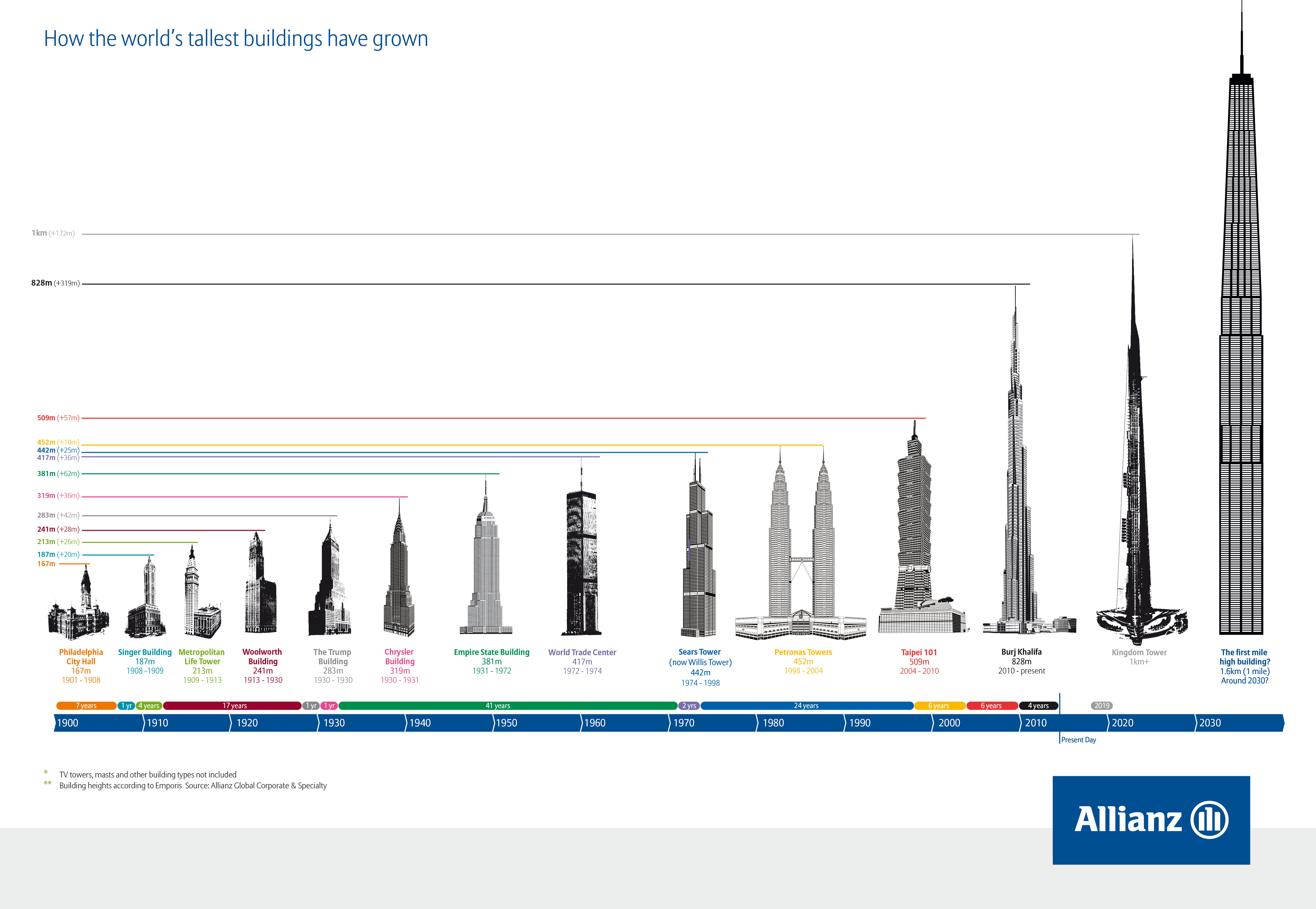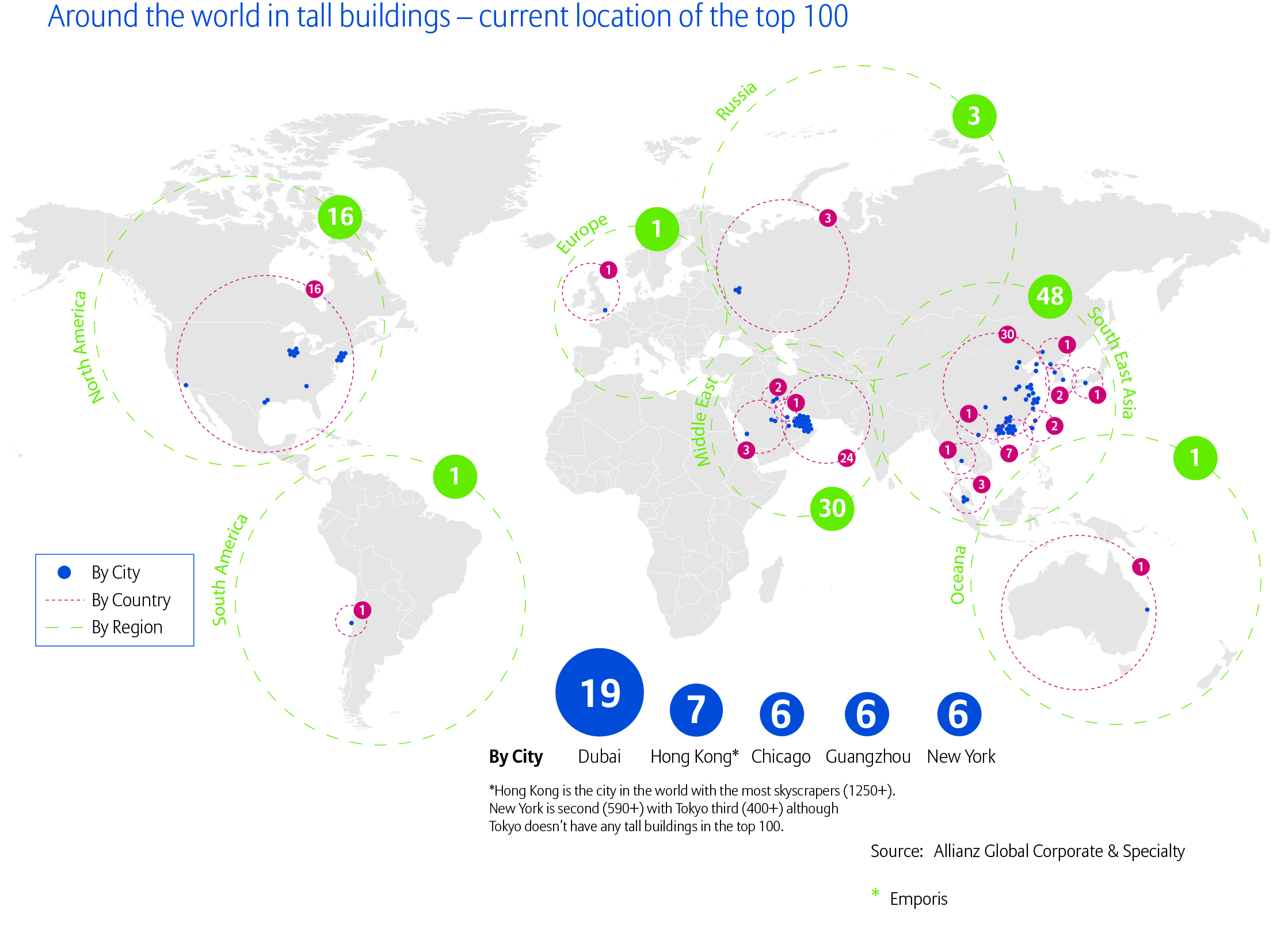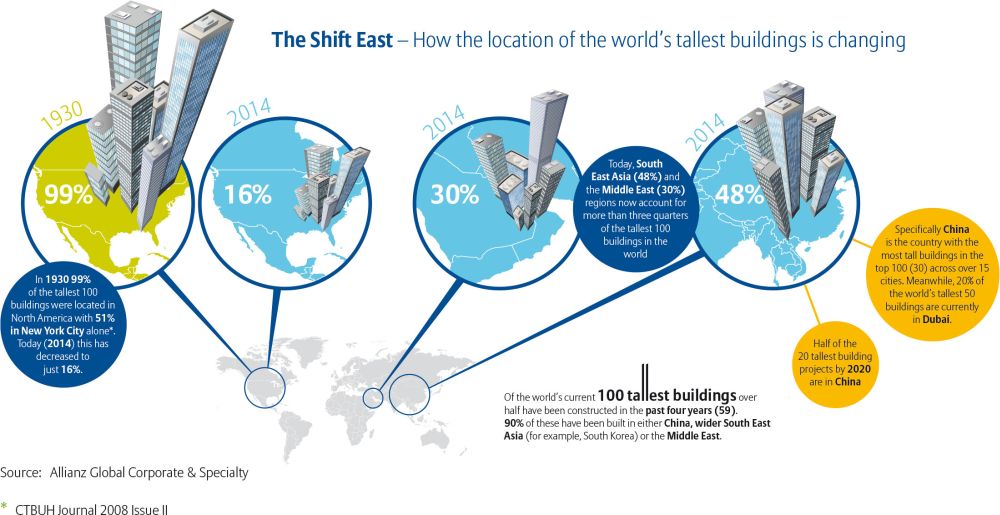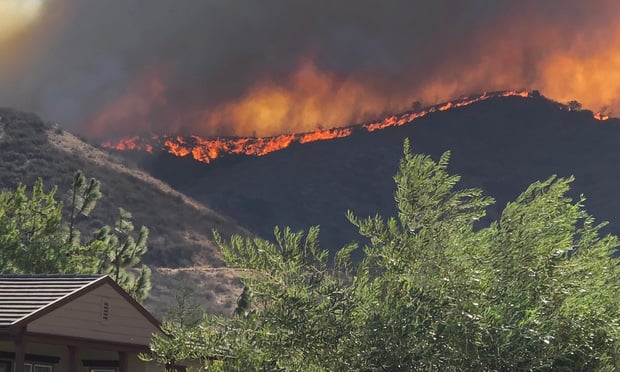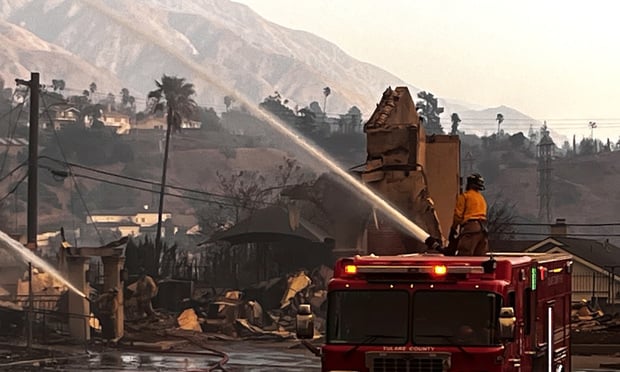Allianz Global Corporate Solutions is the reinsurer of the megascraper. Of the 100 tallest buildings in the world, Allianz insurers every single one of them. This has become a defined specialty for them, but there are still plenty of skyscrapers below 100 stories that need coverage, and that are well tall enough to entail many of the same considerations of their taller brethren when it comes to construction and underwriting.
As AGCS has released its report, “Supertall Buldings,: Construction Risk Assessment in the 21st Century,” it covers many of the particular challenges and opportunities of covering such monumental building projects. We have focused on just four of the most important. We will provide a link to the report at the end of this story. (For a closer look at the following graphic – and we suggest that you do, because it is fascinating – click here to see a hi-res version.)
Concentration of value
Skyscrapers are getting taller than ever. The proposed Kingdom Tower in Jedda, Saudi Arabia, which will be the world's tallest building once completed, at 3,280 feet. It will be the king of the “megascraper,” skyscrapers standing more than 2,000 feet tall. (Incredible to think that the Burj Kalifa will no longer be the world's tallest, eh?).
By 2020, the average total height of the tallest 20 buildings in the world, will be around 2,000 feet. That is twice the height of the Eiffel Tower. Megascrapers might reach a height of one mile, but that won't be likely for another 20 or 30 years, as engineering struggles to find ways to make that a reality.
But that is a radical advancement in a short period of time. Consider this: the Empire State Building, at just 1,250 feet tall, held the world's record for height for more than 40 years. In perhaps only half as much time, the new limit will double, to more than quadruple the Empire State Building's height.
If that doesn't impress you, try this: As megascraper building exploded across the Middle East and Asia, the Taipei Tower held the world's record from 2004-2010, standing at almost 1,700 feet. When the Burj Khalifa was completed, it beat the record handily. How handily? Heightwise, it was like taking the Taipei Tower and then stacking the Chrysler Building on top of it.
With all this height comes value, and a concentration of risk. The average megascraper is a billion-dollar project, to say nothing of what value the building will have once it is fully opened for business and occupied. Keep in mind that the insured losses of the World Trade Center were some $4.5 billion. The Kingdom Tower in Jedda is looking to have an insured value of $1.5 billion.
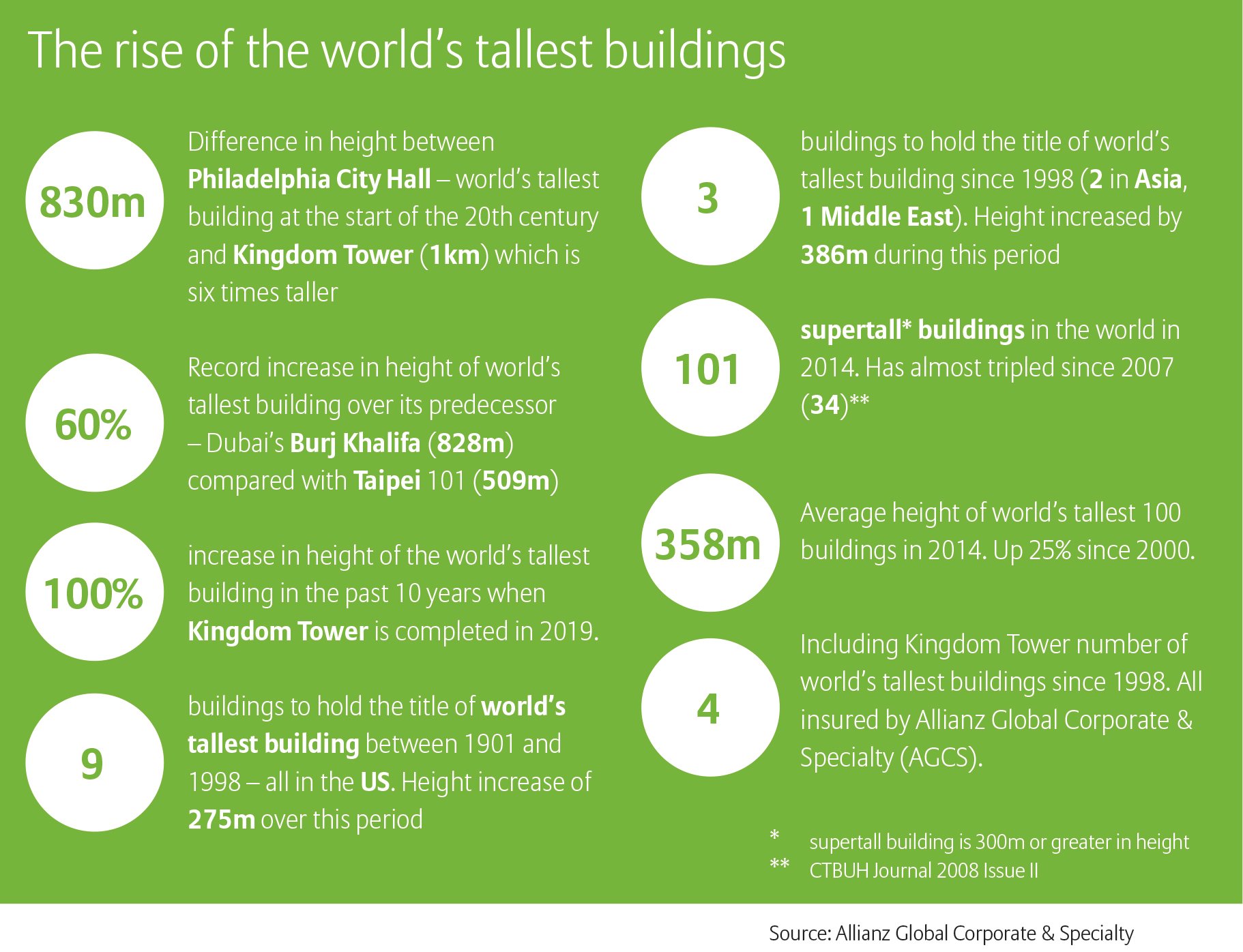
Technical limits
Most skyscrapers hit a limit at 2,000 feet because that's as far as modern elevator technology extends. To build something taller than that, you need to start getting creative, and today's megascrapers certainly are that. Most are not just ambitious economic platforms and national prestige projects, but they are also master classes in architectural and materials innovation. At such heights, even steel and cement have their limits, and there might not be enough alternate materials on hand to build with.
Safety to the surrounding area is also a concern, with special attention paid to damping systems that will reduce negative impact from wind or seismic activity. These are not off-the-shelf solutions. The Taipei Tower, for example, uses 660-ton active pendulum in the center of the building as a mass damper. The Burj Khalifa uses a “buttressed core” and a high-performance method of wall construction to maintain its stability.
Geological considerations must also be taken into consideration. Local geology is what is keeping the Kingdom Tower from getting any taller. And you know how there are areas of Manhattan without skyscrapers? That's because the bedrock there simply won't support them.
Risk factors
Megascrapers involve a number of other special risks, not the least of which is “solar gain” in which the massive amount of sunlight and heat the building absorbs might reach locally dangerous levels.
A supertall construction project can involve as many as 10,000 workers and more than 100 subcontractors. Glass panels and concrete must be specially formualated to withstand the rigors of such specialized construction. As materials are lifted and craned to such extreme heights, wind speed becomes a significant safety factor – the play on the crane at the top of the Freedom Tower was nearly six feet in either direction.
Once supertall buildings are finished, then there are new risks to consider. The sheer weight of the building will eventually impose elastic shortening on its components, for example. And the fire and evacuation requirements become formidable, with multiple use such as hotels, restaurants, offices, shopping centers and residential areas all within the same structure. The World Trade Center evacuated in under an hour during the 9/11 attacks, but only because it took several times longer when the buildings were evacuated after the 1993 WTC bombing.
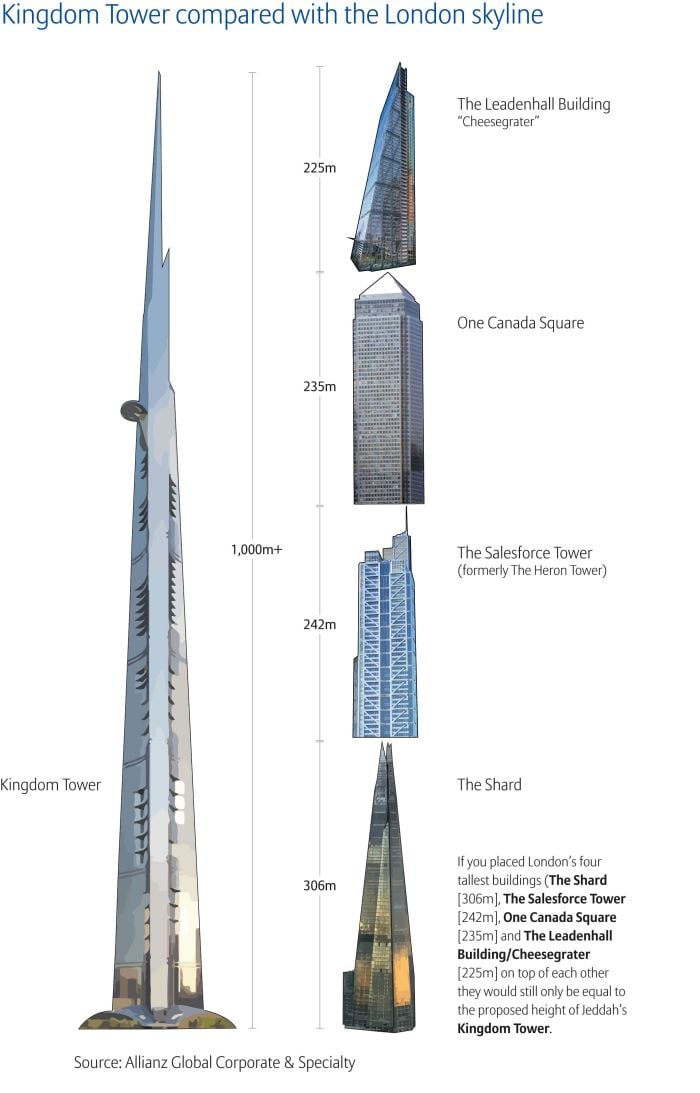
Market concentration
If you're looking to insure the skyscrapers of tomorrow, look outside of the United States. All of the megascraper construction going on these days is in the Middle East and in Asia, where there is an appetite for creating massive flagship structures, and where labor costs are low enough to make these projects economically feasible. The U.S. or Europe certainly have the capability to build the world's tallest building, but the cost of doing so would be prohibitive.
Of the world's 100 tallest buildings, 48 of them are in Southeast Asia. 30 of them are in the Middle East. Another 30 are in China alone. North America, the birthplace of the modern skyscraper and home to some of the 20th century's most iconic skscrapers (and longest-running world record holders for height) has only 15.
Of the world's tallest 50 buildings, 10 of those are in Dubai. Dubai is one of the megascraper capitals of the world. The recently completed Freedom Tower in New York stands at an impressive 1,776 feet tall, but it will be only half the height of the Kingdom Tower, once that building is completed.
Given construction costs, regulatory oversight and a general reluctance to build such enormous buildings (given the terrorism risk they present), it is likely that the torch has passed out of the United States' and Europe's hands in terms of building the world's tallest buildings for the foreseeable future. That said, it might not be such a bad thing. Economists have noted that booms in skyscraper construction are linked to impending financial crashes. Maybe Asia and the Middle East are creating a dark omen for themselves.
* * *
For more on insuring supertall buildings, check out ACGS's report, which you can download here.
Want to continue reading?
Become a Free PropertyCasualty360 Digital Reader
Your access to unlimited PropertyCasualty360 content isn’t changing.
Once you are an ALM digital member, you’ll receive:
- Breaking insurance news and analysis, on-site and via our newsletters and custom alerts
- Weekly Insurance Speak podcast featuring exclusive interviews with industry leaders
- Educational webcasts, white papers, and ebooks from industry thought leaders
- Critical converage of the employee benefits and financial advisory markets on our other ALM sites, BenefitsPRO and ThinkAdvisor
Already have an account? Sign In Now
© 2025 ALM Global, LLC, All Rights Reserved. Request academic re-use from www.copyright.com. All other uses, submit a request to [email protected]. For more information visit Asset & Logo Licensing.


